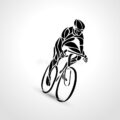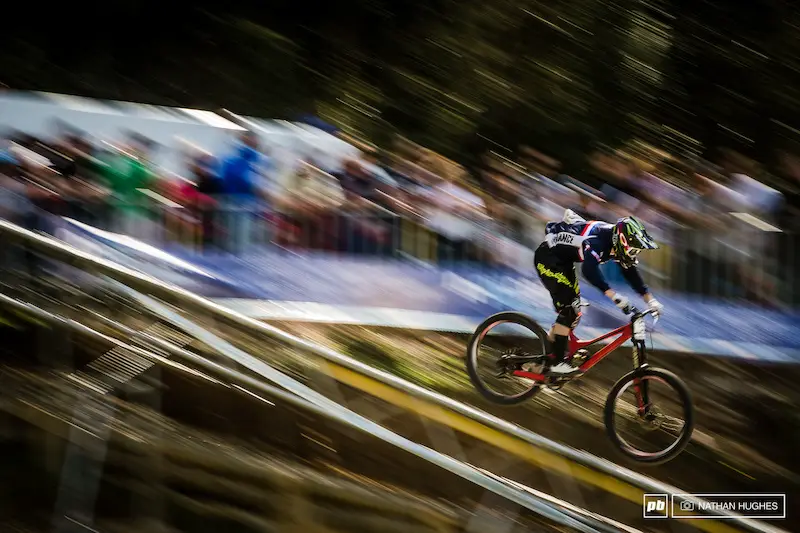Just how fast can a bike go downhill is a question for many mountain bikers and even other cyclists such as road bikers that may want to rip down hills.
On uphill sections, the average road bike or mountain bike could average about 13 kph or 8 mph. On downhill sections, most bikes’ average speed will double to up to 27 kph or 17 mph. The highest speed for a mountain bike going downhill could be as high as 48 kph or 30 mph.
Can you go 60 mph on a bike
On a conventional bike, it is not possible to go 60 mph. While you may believe gearing is the problem, that is not the biggest issue as compared to aerodynamics.
Aerodynamic drag typically goes up with the square of your speed and you will require about 4000 Watts which most professional sprinters can only keep up for a few seconds.
As such 60 mph can only be achieved in an aerodynamic high-performance vehicle (HPV). The current record for such a vehicle is 90 kph which is just short of 60 mph.
However, some HPVs have gone as high as 144 kph over sprint distances. Still, these vehicles would not be practical for mass-start events such as Tour de France. As such these speeds cannot be achieved on production or even race bikes.
how fast can a road bike go downhill?
The fastest unassisted speed is about 80 mph or 130 kph. It is important to note that the speed that you can attain on your road bike is impacted by several factors with the most important being air resistance and gravitational force.
Air resistance is something that all cyclists have to deal with but on the road bike which is more aerodynamic less of a profile is presented thus reducing air resistance. On the other hand, gravity acts as an accelerant as it draws you toward the bottom of the hill thus making you faster.
how fast can a mountain bike go downhill?
A mountain bike can go for between 30-37 mph on downhill rides
How Fast Do Cyclists Go Downhill
How fast you can rip down hills often depends on experience even though there have been reports on Reddit and other forums of riders going as high as 25-35 mph downhill. However, I believe this is too fast for a beginner cyclist and could potentially be dangerous.
As for experienced cyclists, speeds of up to 45 mph or even more are not uncommon even though most people even the most experienced will try to get down to 23-30 mph on hairpins and tight turns. Speed is often also impacted by how heavy the traffic is or how good or bad the weather happens to be.
What is the fastest downhill bike speed?
The world’s fastest downhill ride record is held by Max Stockl an Austrian downhill rider who achieved the record riding a stock mountain bike in the Atacama desert in Chile where he reached a top speed of 104 mph or 167 km/h.
The forty-two-year-old cyclist is somewhat of a senior cyclist who has always had a thirst for speed which he got from downhill riding. The mountain bike rider chose a 3972-meter summit of a desert mountain named Cerro El Flaco which has a 45-degree slope and rode his bike on a 1200-meter slope to achieve his record.
How to descend like a pro
Professional cyclists tend to be better at riding fast downhill than beginners. The following is how to become better and eventually a pro at taking a bike downhill fast:
- Check the Brakes – Take the bike to a shop to have the brakes checked out at least once every year. Most people do not bother with checking the brakes though they are one of the most important components of the bike.
- Check Tire Pressure – Road tires are best at a pressure of 110 pounds per square inch. This will ensure that your tires are on the slightly squishy side which improves contact with the road surface. If you are riding on hybrid or mountain bike tires you may require less pressure given that they usually have better grip as they are wider.
- Sit Correctly – Beginner cyclists will often lock and straighten their elbows on steep descents which means they are usually levitating on the bikes which makes one very unstable. Instead, you should have most of the weight borne by the feet with your backside on the center of the seat and the shoes pressing on the pedals. You should also relax the shoulders and bend the elbows.
- Loosely Clutch the Brakes and Handlebars – Lightly test the palms over the handlebars and let the brake hoods be in the crook of the thumb, and only one finger resting on the brake lever. The trick is to have most of your body weight on the pedals rather than on the bars.
- Look Down the Road – Do not look down but rather farther down the road so that you can notice all the curves and potholes coming up and respond accordingly rather than jerking your bike out of the way at the last minute.
- Avoid Fixating on Things – Do not fixate or stare at bumps or stones in the road as you will tend to steer right into the obstacle. Look at the place where you want to go around the obstacle and the bike will follow your vision. If you scan the road properly you should have enough time to plan your maneuvers.
- Start Small – It is always advisable to start with gentle slopes or ones you are familiar with. Descend at comfortable speeds and start using a single tip each time and then build confidence each time you do it.
- Ask Good Riders for Advice – Talk to good riders and watch how they do it. Many local bike shops offer clinics and rides to cyclists on the beginner to pro spectrum. You can also find an experienced cyclist and follow them down the hill to watch their technique

How fast do you need to go to safely stop
While many people are obsessed with how fast they can go, the real question is how fast can you go and still be able to safely stop. On long roads with no chance of animals, side roads, gravel, dirt, and braking cars, the maximum speed of descent is up to you.
In the real world though where you have to deal with these things, you will definitely hurt yourself badly descending at 40 mph. Braking at such high speeds will be just like in a car more of a challenge.
Moreover, the faster you will be going the longer you will have to brake. Additionally, the brakes will not work so well given that you will also be fighting gravity and overheating brakes.

Will high speeds cause components to fail?
It is highly unlikely that riding at high speeds will cause components to start falling off the bike.
However, you have to remember that most components such as tires have a physical limit to how much punishment they can take.
For instance, if you rigged a bicycle wheel on a Suzuki Hayabusa and drive at 250 kilometers an hour, the tire will give at some point. Whether you will maintain that speed for half an hour or hit 250 km/h before it happens is a different matter.
A bike may be badly constructed and unable to tolerate the stresses of speed placed upon it. However, this will typically be manifested in instability such as wobbling or weaving rather than the tire failing at high speeds.
For Components such as brakes, they may wear out or melt if you apply them for long enough. Since you are going downhill you may have to brake hard for a considerable part of the descent through the failure of the component may have more to do with the application of brakes rather than the speed.


